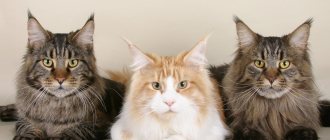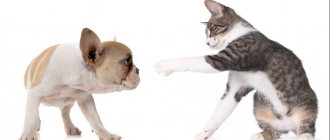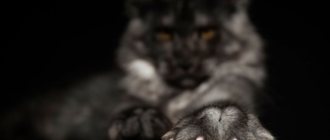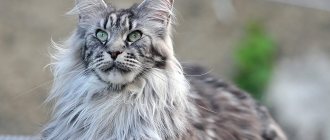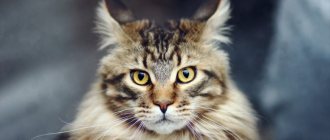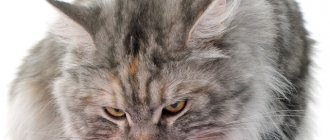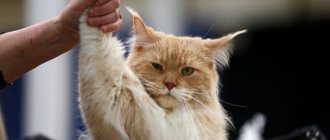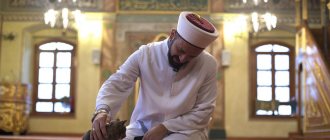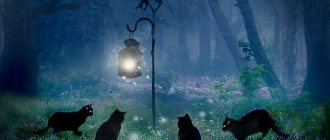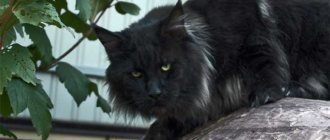Large sizes, tufts on the tips of the ears and other striking differences from other cats have given rise to many legends and myths about the appearance of Maine coon seals.
There are several assumptions related to the history of the origin of the Maine Coon breed - there are both romantic variations, largely based on the appearance of the animals, and scientific theories put forward by zoologists.
The future owner is recommended to first learn as much as possible about the pet - where the name of the breed came from, how Maine Coons developed not only in Europe, but also in Russia.
History of the name
Maine Coon literally means "Maine Raccoon". The ancestors of this breed provided themselves with food by hunting small birds, mice and rats.
The rats ate farmers' grain reserves, so they began to tame cats - they, in turn, lived with people and went for walks in the forest. Over time, pets became more and more domesticated - they did not need special care and did not cause unnecessary trouble to people.
Appearance
The appearance of the glorious Maine Coon family was significantly influenced by the climate of Maine: it is very difficult to survive in the cold and snowy continental winter without a thick undercoat. A wide paw, protected by additional tufts of fur, is also a useful device that helps to slide along the ice crust without falling into the snow.
Well, its impressive size is an invaluable advantage when hunting small animals. As for modern representatives of the breed, their appearance could not help but be affected by the passion of European breeders for extremism. Today's Maine Coons have significantly increased in size, their faces have become even more elongated, and their ears have grown significantly.
Head
The Maine Coon's muzzle
is massive, noticeably elongated in length, with a relief profile, high cheekbones and a medium-length nose. Since the ancestors of modern Maine Coons hunted rodents, they often had to “dive” into holes for prey, which became the main prerequisite for the formation of a somewhat elongated skull shape.
Eyes
The eyes are round in shape, set wide and slightly oblique. The shade of the iris varies from green to rich yellow and is in harmony with the color of the animal.
Ears
Large in size, with a wide base and a slight forward tilt. A distinctive feature is the “lynx tassels” and “brushes” peeking out from the ear flap. It was the outstanding size of the ear that helped Maine Coons become excellent mousecatchers, for which the breed is especially loved by American farmers.
The skin on the ears is thick, protected by thick hair, and the cartilage structure is dense. To maximize heat retention and protect the hearing organs, coons use an ancient technique: the animal presses its ears tightly to its head, as if folding them, which prevents icy air from penetrating inside the funnel.
Neck
Maine Coon kitten The
neck of Maine Coons is strong, muscular, of medium length, decorated with lush and long hair. Among breeders, individuals with a neck “collar” reaching to the ear flaps are especially valued.
Body
Elongated, close to a rectangle in shape, with well-developed muscle mass. The chest is quite wide, the shape of the back is horizontal.
Limbs
Tall, muscular and very strong. Set wide apart.
Paws
Massive, round in shape, protected by a dense “edge”.
Tail
The Maine Coon's tail is long (equal in size to the length of the body), with a wide base, without kinks. Covered with thick hair, under which a dense, water-repellent undercoat is hidden. In extreme weather conditions, the tail acts as a natural heater: the animal wraps it around the body, thereby protecting itself from the cold.
Wool
The Maine Coon's coat is long (from 10 to 15 cm), but uneven, gradually increasing in volume from the shoulders to the belly. The most luxuriant wool is in the area of the so-called “pants”. In the dorsal area, the cover is more rigid with a predominance of guard hairs. The belly and sides are protected by a soft downy undercoat, the main purpose of which is warming and water-repellent.
Color
A Maine Coon drinks tap water.
Individuals bred in nurseries in different countries can vary quite a lot in both color and size. Recently, cats of any color are allowed to participate in exhibitions, with the exceptions of point, lilac and chocolate. At the same time, the classic “identifying shades” of coons are considered to be agouti, brindle black, marbled black and white (the latter option is widespread in Russia).
Possible defects
If a Maine Coon's appearance does not conform to generally accepted standards, it automatically excludes it from the ranks of the show class. In other words, such individuals are barred from entering exhibitions.
Reasons for “excluding” a cat from participating in all kinds of competitions may be insufficiently fluffy fur in the belly area, too short a tail, small size of the animal, spots and specks on the fur, a relief shape of the nose (the presence of a noticeable depression in the middle), wide-set ears, uniform length of fur throughout the body.
A genetic anomaly such as polydactyly (the presence of an excess number of toes on a cat’s paws) is also considered a significant reason for banning an animal from participating in public events. At one time, this mutation was widespread among Maine Coons, which is why it received the status of the main defect of the breed.
Legends about the origin of Maine Coons
The state of Maine in America is considered to be the place of origin of Maine Coon cats, but the variants of their appearance are strikingly different from each other.
Marriage between a cat and a raccoon or lynx
The essence of this myth is that cats brought to America from Asia crossed with raccoons. Proponents of this theory cite the color of the Maine Coon's coat and the appearance of its tail as evidence.
No less popular is the legend about the connection between a lynx and a cat, which led to the appearance of Maine Coons - it arose due to the characteristic tufts on the pets' ears.
In turn, from a genetic point of view, such unions cannot exist, since animals of these species differ in the set of chromosomes.
Cat on a ship
There are several sea stories about the appearance of Maine Coons:
- One of them tells the story of Captain Kun, nicknamed “Raccoon” by the sailors. He went on his voyages with his favorite pets - a cat and cats, distinguished by their large size and long fur. On the ship they ate mice, thereby protecting the crew's supplies from spoilage. After each call to the port, the animals gave birth to offspring, and Kun gave some of the grown kittens to his friends.
- Another version of the story of the original origin of cats of this breed is based on the fact that “Raccoon” distributed kittens to residents of Maine. Growing up, they created alliances with American cats and female cats, which was the reason for the appearance of the Maine Coon representatives.
- The third myth is that Scandinavian sailors took cats on board their ships to hunt rats. They chose hardy, large-sized specimens accustomed to difficult living conditions. In ports, animals came onto land and mated with local cats.
- There is also an opinion that cabin boy Tom Coon sold kittens in Maine that were born on the ship during the voyage - they became the first representatives of the Maine Coon breed.
There is a legend that the ancestors of these cats are animals that survived before the destruction of Atlantis. One of these cats ended up in Russia and became the ancestor of Siberian seals. Another led to the appearance of representatives of the Norwegian breed, and the third led directly to the Maine Coons.
Connection with the Queen
There is another popular legend - Marie Antoinette made every effort to escape from the prison in which she was put by the revolutionaries. She ordered all her property to be loaded onto the ships and sent towards America. Among the riches were the royal favorites - large fluffy cats.
The queen never escaped, but the loaded ships arrived in America, where the pets crossed with local cats, resulting in the Maine Coon.
Viking deity
The Vikings deified the image of a cat, associating it with Freya, the goddess of war, fertility, beauty and love. Even before Columbus, they visited America more than once, and the ancestors of modern Maine Coons were always present on their ships.
There is an opinion that these were large Norwegian cats with thick hair - they left the ship without permission and mated with local cats, this was the reason for the appearance of the original breed.
This theory is considered the most plausible, since genetic tests have confirmed the similarities between the Norwegian cat and Maine Coons, but scientists do not agree with any of the above myths.
Health
Maine Coons are distinguished by excellent health, which is due to their origin and genetic adaptation to survival in the harsh conditions of long winters.
According to statistics, the life expectancy of representatives of this breed is 13 years or more. More than half of the cats recorded live for more than 16.5 years.
The most serious health problems in Maine Coons are the same as in humans - diseases of the cardiovascular system.
Hypertrophic cardiomyopathy is the most common pathology in cats, including representatives of this breed.
As a rule, this disease affects cats of middle and old age, so it is important to monitor the health of your pet and regularly show it to the veterinarian, since with timely diagnosis the disease can be corrected.
Another problem that can arise in this breed is spinal muscular atrophy. This pathology is also inherited by cats in an autosomal recessive manner and is characterized by damage to the nerve fibers of the spinal cord responsible for the innervation of the muscles of the skeleton and limbs. This disease manifests itself early in kittens, as early as three or four months of age.
The disease prevents the animal from jumping high, but in general these babies eat well, play well and can live well for a long time, like all other cats.
The musculoskeletal system of a pet of this breed can be affected by a disease such as hip dysplasia. This is also a hereditary disease, which most often manifests itself in old age, mainly in males: they begin to suffer from arthritis and limp. Maine Coons can also get sick with another genetically determined disease - polycystic kidney disease.
In general, the likelihood of serious illnesses in representatives of this breed is quite low: they have excellent heredity, since the health of Maine Coons was formed through natural selection, and not selection.
True origin story
There are several ways to breed a new breed of animal:
- naturally;
- through artificial crossing.
From the point of view of biologists, Maine Coons appeared as a result of natural evolution, namely, they descended from their American ancestors, without human intervention. Their distinctive external features arose as a result of the harsh climate of their place of residence.
Interesting! Over time, the ancestors of the breed adapted to the living conditions - their thick and long hair protected them from the cold, their long paws allowed them to move through the snow without much difficulty, and they rested on their bushy tail.
Description of the breed
Let’s say right away that the Maine Coon is a cat for real aesthetes. Even looking at these animals brings incredible pleasure. Judge for yourself:
Maine Coon weight and size
These representatives of the cat family are distinguished by their large physique. The average weight of a cat varies between 9-10 kg, and neutered cats often approach the 13 kg mark. As for the body length, it can exceed 100 cm!
Important! The largest Maine Coon in nature is considered to be the cat Cutie. This Guinness Book of Records record holder weighs 16 kg with a body length of 123 cm.
Further history of development
In America
Chronology of Maine Coon breeding in the United States of America:
- For the first time, Maine Coons participated in an exhibition in 1861 in New York, and felinologists registered the first record in 1908. A cat named Captain Jenks was exhibited, which delighted all the spectators.
- In 1878, 10 pets of this breed were presented at the exhibition.
- In the 1930–1940s, the fame of this breed faded and Persian cats came to the fore.
- In 1980, there were more than one thousand Maine Coon owners in the country.
Today in America the Maine Coon is the third most common breed.
In Europe
The first representative of the breed appeared in France in 1981, and his name was Charlie. A few years later, Maine Coons were brought to England. In 1993, a souvenir coin with the image of a pet appeared in the UK.
Kinds
The breed is considered native and one of the oldest in North America. But breeders from Europe created new lines, leaving a recognizable appearance, but assigning new features to the cats. This is how two intrabreed lines appeared - American and European.
- American Coons have a strong and strong bone structure; they are slightly lower than their European relatives, but are not inferior to them in weight and power. Americans have a wide head; the transition from the convex forehead to the muzzle is more noticeable. The eyes are round. The ears are shorter and wider apart than those of Europeans, and lush “lynx” tassels are not adopted. Outwardly, they are more similar to the Norwegian forest or Siberian breed.
- The European type was formed in the 90s of the last century. An important difference is slightly slanted and squinted eyes. It was these individuals who became famous for their slightly predatory and contemptuous gaze due to the unusual shape of their eyes. Their muzzle appears triangular, the body is often elongated, the tail is long, along the back it should reach the shoulder. The paws are high.
Care
Caring for cats is labor-intensive. Requires a lot of time and effort. The reward is a happy, beautiful and loving pet.
Check your ears and eyes regularly. If dirt and wax have accumulated in your ears, remove them with a cotton swab soaked in a special lotion.
The cat's eyes should be clear. If there is discharge in them, remove them with a special napkin. If there is none, use a swab moistened with boiled water or eye lotion. It is not recommended to use chamomile infusion. It has a bad effect on the hair around the eyes.
Wool
A kitten must be taught to care for its fur literally from the first days it arrives in the house. If you don't do this, he won't like handling the comb later. He will resist and may show aggression.
Starting from six months, kittens' coats change. The baby's undercoat falls out. The fur becomes thick and tough. To make this period pass faster, the animal must be combed at least twice a week.
In addition, during this period the pet’s body especially needs vitamins and microelements. If there are not enough of them, the period of baby molting will drag on for a long time. The appearance of the coat will deteriorate.
An adult animal sheds twice a year - in spring and autumn. For cats that live in apartments, their schedule is often disrupted. Shedding may occur earlier or later and may take longer.
In addition to seasonal molting, the coat is constantly renewed. Experts say that each hair on a Maine Coon “lives” for about a month and then falls out.
Regular brushing will help maintain the beauty of the coat and prevent the formation of tangles. Makes it easier to maintain cleanliness in the apartment.
If the cat is not brushed, he will lick the fur off himself. As a result, it will accumulate in the intestines, which can lead to health problems.
How to brush a Maine Coon
This must be done in several stages.
First, comb the animal with a wide-toothed comb. This will allow you to identify problem areas.
Most often, hair rolls up behind the ears, on the stomach, chest, lower neck, and hind legs.
Carefully remove any tangles found with your hands. Try combing. If that doesn't work, cut them out with scissors.
After this, comb the coat with a fine-toothed comb. This will remove the undercoat and “outdated” hairs.
Bathing
Maine Coons love water. If babies are introduced to water baths from an early age, they will begin to enjoy the procedure.
You need to bathe your cat in warm water – 35 degrees. Place a rubber mat or towel on the bottom of the bath to prevent your pet from slipping and falling. Make sure that water does not get into your pet's ears.
Maine Coons need to be washed with special shampoos for long-haired cats. Then rinse with water.
Upon completion of the procedure, the animal should be dipped in a soft towel. If you rub too hard, the fur may become tangled.
After the bath, make sure that the cat does not get caught in a draft and catch a cold. To prevent this from happening, dry the fur coat a little with a hairdryer. Then let the cat finish the job himself - lick the fur.
Nail care
Cats themselves monitor the length of their claws. If necessary, grind them off or bite off the ends. However, the owner must keep this process under control.
Maine Coons need to sharpen their claws. To prevent cats from damaging the furniture in the apartment, it is necessary to install special scratching posts. If they are not there, then there is a high probability that upholstered furniture or door jambs will be damaged. Claw grinders must be well secured so that a large cat cannot turn it over or drop it on the floor.
It must be borne in mind that even if a pet uses a scratching post, this does not guarantee that he will put his claws in order on his own. It is necessary to control the length of your pet's claws, otherwise they will cause discomfort and problems for the raccoon cat.
The claws on the front paws are always longer than those on the hind paws.
If the claws are very long and cause discomfort to the pet, they need to be trimmed a little. This can be done at a pet salon, veterinary clinic, or invite a specialist.
The owner can trim the pet's claws himself. However, inexperienced people should not undertake this procedure. The claw contains blood vessels. If they are damaged, severe bleeding will occur.
Particular attention should be paid to the fifth toes on the front paws. These fingers do not come into contact with the ground or floor. Long claws grow on them and begin to bend at the end. Sometimes it grows into the skin. The pet is in severe pain. To prevent this from happening, the claws need to be trimmed on time.
If a cat breaks a claw while playing, its sharp tip must be trimmed. Otherwise, a fragment of the claw will damage the animal's paw. The wound must be treated with an antiseptic.
What to feed
The cat must be fed food prepared especially for it. Food from the owner's table is harmful to the pet. This is due to the characteristics of the animal’s digestive system, which differs from the human one. Food from the owner's table is poorly digested and can cause a number of diseases.
There are two options for feeding the animal:
- natural,
- industrial feed.
You can choose a natural diet for your pet only if you have the time to cook especially for him.
Foods that are good for Maine Coons
- Lean meat: horse meat, beef, lamb, rabbit, turkey, chicken.
- Offal: heart, tripe, liver.
- Vegetables: carrots, pumpkin, zucchini, cauliflower. They can
- Greens: parsley, dill, lettuce.
- Cereals: oatmeal, rice, buckwheat.
- Sea fish: hake, pollock, pink salmon.
- Chicken and quail eggs.
- Fermented milk products: cottage cheese, kefir, yogurt, Varenets.
- Vegetable oil. It should be added to vegetables and cereals 1⁄2 teaspoon. Sunflower, olive, flaxseed are suitable.
Forbidden food
- Fat meat. Causes disruption of the digestive system. Frequent use can lead to the death of the animal.
- Bones. Can injure the gastrointestinal tract.
- Milk. Causes indigestion.
- Beans. Lead to bloating and flatulence.
- Noodles. Buns and pies. Provokes gastrointestinal colic, bloating and diarrhea.
- You should not feed your cat salty food. Because of it, the risk of cardiovascular diseases increases.
An adult Maine Coon should be fed 2 times a day. To do this, the daily food intake should be divided into two meals.
The cat should always have access to a cup of clean water
If you don’t have time to prepare food for your cat, commercial food will help get out of the situation. Choose a product from one of three classes:
- premium;
- super premium;
- holistic.
Depending on the consistency, industrial feeds are divided into 2 types: dry and wet.
Each has its own advantages and disadvantages.
Dry food can remain in a cat's bowl for 24 hours. There is no moisture in it. When using it, your pet must be provided with access to clean and fresh water.
Wet food is available in the form of jellies and pates. It is well absorbed by the cat's body. It is not only nutritious, but also high in calories. Pets love him. If it is abused, the coon may become overweight.
You can combine dry food with wet food. In this case, dry food should account for 75% of the daily ration, respectively wet food - 25%.
Food for a Maine Coon should be selected taking into account age, health status and energy costs. It is important to follow the dosage specified by the manufacturer.
Character traits
At first glance, the unrealistically large size, meaningful look and luxurious fur are striking, although this is not all that can attract a person’s attention. People who are the owners of these animals can talk about their pet for quite a long time and surprise the interlocutor.
Cats play like little kittens, with enthusiasm, and during games they look funny and it is impossible to watch them without smiling.
And when the owner is doing some kind of work and is particularly busy with it, his pet will not leave this matter unattended and will definitely go to “help”. The cats will remain nearby throughout the entire activity, or until the work is completed.
When people come to visit, they are afraid at the sight of a large animal and often think that they will be attacked and at least scratched. But all this is in vain, they are very gentle and affectionate, they love peace, and can meet anyone with a perky purr.
The Maine Coon grows from 3 to 5 years, and small kittens are very easy to train.
Earlier it was said that they are hunters and therefore it is advisable to make a tree for them at home to make their well-being more comfortable. It is recommended to calculate such a structure based on the maximum weight of the animal when making it yourself or purchasing it at a pet store.
Its presence in the interior is necessary for sharpening claws, climbing and various games. It is desirable for cats to have an individual space where no one will disturb them. Having matured, Maine Coons do not play with the same passion as little kittens, they are lazier, but, nevertheless, their interest in observing events does not go away.
Sometimes the desire to run and frolic also attacks adult animals, so they need a specially allocated place, taking into account their large size. If you give them a tasty piece to eat, for example, a chicken breast, then they don’t eat it all right away, but after trying a piece, they begin to play with it, pushing it far under the furniture, where possible. During the game, they can perform various virtuoso acrobatic exercises and tricks, and you can watch them throughout the entire show.
These cats amaze with their self-confidence and self-esteem. They do not have the habit of climbing on the table and stealing food, even if they are hungry, they will never even ask for food, because they have a sense of pride from birth.
They find a common language with representatives of other animals, and communication is successful, despite their natural pride. They also respect dogs and do not react to their approach by hissing and ruffling them, like ordinary cats.
But if there are mice or rats at home, then we can assure you with one hundred percent certainty that soon there will be none left, because Maine Coons are excellent hunters.
If the house is filled with flies or midges, then there is no doubt that the cats will catch them all. They can simply look at the birds from the window without making any attempt to catch them. In addition, if a cat was raised with other representatives of small animals, then he is accustomed to them, so they do not need to be afraid of him. Maine Coons are also indifferent to aquarium fish.
And here is another difference from ordinary cats: they never meow, but utter sounds that, due to inexperience, cannot be distinguished from human ones. When cats say something, you can hear the difference in the shades of their voices, so many owners understand what their favorite cat is talking about. And another revealed fact is that they are intellectuals and understand their owners perfectly, they never wake them up in the morning, even if they are very hungry.
No less noticeable is such a character trait as accuracy. For example, if something is spilled on the floor, the cat will definitely go around it so as not to get dirty. They can go to bed in any place, and the positions taken at this time can be unimaginable and masterly, which cannot but cause surprise in any person who sees it.
Many owners of this breed claim that their pet knows much more than the owner how things are in the house. Since Maine Coons are smart and naturally well-mannered, they are distinguished by their intelligence.
There is no need to spend a lot of time for the training process, since the animal understands words perfectly. Many people believe that these cats are smarter than some people.
Publication and recognition
The Maine Coon actually almost joined the list of cat breeds that have disappeared forever. For some time, due to the small size of the group, he was even deprived of breeding status in the records of the national association, which is necessary for further registration of the breed.
Only in the 70s, through the efforts of enthusiasts, was it possible to return the big cat from historical oblivion.
- 1973 – organization of the American Maine Coon Fans Club.
- 1975 – preliminary recognition status in the CFA (Federation of Cat Fanciers and one of 9 participants in the World Felinological Congress).
- 1976 – obtaining permission to award the champion title in the Maine Coon breed.
From that moment on, the dark years in the fate of big cats ended, and a white streak began. In 1985, the Maine Coon was officially registered as the state breed of Maine.
Felinologists and breeders also rushed to make up for lost time. The Maine Coon has new colors, and breeders have adopted a national breeding program and identified only three breeds of cats with which the furry giants are allowed to be crossed.
Main features of raccoon cats
Maine Coons develop slowly, only by the age of five do they reach maturity, becoming more than a meter long, and weighing up to 15 (or even more) kilograms (males). These giants are gentle and good-natured, despite their formidable appearance.
They have a slightly elongated head, a slightly curved profile, and high cheekbones. The ears are quite pubescent, and at the tips they are decorated with almost lynx-like tassels.
Coons also have incredibly long mustaches, which helped them, when living in the wild, not to stumble upon bushes or tree branches in the dark.
The body differs in its length. But the Coons have the same long tail - their real pride. For a cat, this is a fairly essential element of survival. It protects the animal from the cold. When he has to lie on the frozen ground, he wraps himself in this shock of six, keeping warm.
Many animals with long fluffy tails do the same. He also plays the role of a “steering wheel” that coordinates Kun’s movements.
The fur of these giant cats is dense and long, which is characteristically water-repellent and protects from external influences.
Nutrition
Such a large breed of cat eats a lot and often. In nutrition, it is important to choose a direction - either you buy ready-made food of the highest class, or stop at natural products. If you choose the first option, add canned food to dry food 2-3 times a week, and these should be products from the same manufacturer. In the second case, there are also some tips:
- Protein foods that suit him include raw and boiled beef, rabbit and turkey. Pork, duck and goose meat should not be included in the diet, they are too fatty for it. You also need to give up sausages and smoked meats. Sea fish and boiled fish are preferable.
- Include fermented milk products, boiled yolks and quail eggs in your diet.
- The need for fiber is satisfied by selecting cereal porridges.
- Vitamins and minerals are added separately, as well as in the form of sprouted grains. General rules for all types of feeding: be sure to monitor the presence of water in the bowl, do not forget to give a special paste for removing hair from the stomach and buy a glass or metal bowl, plastic may cause be irritating to the skin.
